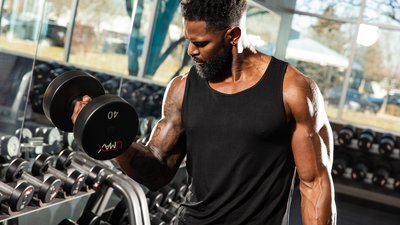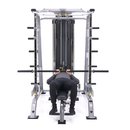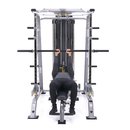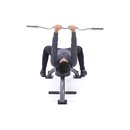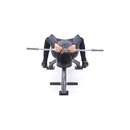Everybody wants big arms, that's a given. Unfortunately some of the methods people use just don't work. This article will lay out a killer arm routine that guarantees results, as long as you follow the guidelines. First, some general rules/information has to be presented.
You Will Not Gain Anything If Your Diet Is Not in Line!
This cannot be stressed enough. Diet is extremely important if you want to gain anything at all. I'm not going to get into detail, but if you eat crap, you will look like crap.
Clean up your diet and start eating a surplus of calories. Your body will be primed for growth then.
Remember: no diet = no arms.
Compound Movements Are A Must
Compound movements are the bread and butter of mass gaining. The workout I am providing will definitely help you pack on mass, but you need a solid foundation.
Having a separate day for arms is fine, but you must also have a day for back, shoulders, and chest. Compound movements in those areas will greatly help build overall mass and mass on your biceps and triceps.
Here is what I am talking about:
Compound Movements That Hit The Biceps:
- Deadlifts
- Chin-ups
- Rows (bent, DB, prone, bench, cable)
Compound Movements That Hit The Triceps:
- Bench Presses (flat, incline, decline)
- Close-Grip Bench Press
- Dips
- Military Press
Progression Is Key
No matter what routine you're doing, you must always remember that progression is important. Progression will make your muscles bigger and stronger.
Progression will also keep you motivated to keep working out. Don't worry about adding 10+ Lbs. to each lift every week, that's where people go wrong. They add too much weight, don't progress or grow, and then lose motivation.
Add small increments each week, or a couple reps. As long as you're progressing, you will grow.
Triceps Make Up Most Of Your Arm
True! This is something that is also misunderstood by most of the mainstream folk. What they're looking for is some "biceps blasting" workout, and they're just looking to get huge biceps.
Well it's the triceps that are going to stretch the tape more, because they make up most of your arm! So in any weight lifting program, do not neglect triceps.
Your Biceps Peak Is Genetic
This relates to the last point, when everybody is looking for the best biceps routine; they're looking to get a massive peak. Sorry to break the news to you, but whether or not you have a peak, and how big it is, is genetic.
There are exercises that isolate the biceps more, but you can't get a huge peak if it's not in your genetics. But you can still have big arms.
Now with those few general guidelines out of the way, let's get to what you've all been waiting for:
Paul's Sleeve Stretching Arm Routine
This routine will be 8 weeks long, and should induce a good amount of muscle growth on your arms. Depending on how the routine works, you may want to keep it and use it all the time. You may want to keep the routine, but change up the exercises after the 8 weeks.
All of this is fine, as long as you're progressing. First we are going to cover the base of the program, and the methods used.
6-Second Negatives
The eccentric portion of movements has been proven over and over to benefit hypertrophy more than the concentric portion. The eccentric portion is the part of the lift where the muscles are lengthening (ex. the down portion of a curl or bench press).
It's also the part of the lift where you should inhale. The negatives are what create the most microtrauma, which will lead to bigger signals for growth [1].
The downside to this though, is that negatives are harder on the CNS (Central Nervous System). If you do them too much, you'll overtrain (your genetics determine how much you can handle, so different people will overtrain faster or slower than others). That is why only 1 exercise for biceps and 1 exercise for triceps will be stressed with a slow negative.
Each of the other exercises will yield a 2 second controlled negative. The concentric portion of the lift will be in a controlled fashion, usually about 1 second.
Supersets
The main purpose of supersets in this routine is to save time. You will superset biceps and triceps movements, meaning that after you finish your first set for biceps, you'll go straight into your first set for triceps.
You'll then rest, and hit the second set for biceps, followed immediately by the second set for triceps, etc.
Extreme (Fascia) Stretching
You will perform extreme stretching for the biceps and triceps at the very end of each workout. Here, you're stretching the fascia of the muscle to allow more room for growth.
This stretching is going to be painful, but remember, it's supposed to be. Here are the two stretches that you will perform:
Biceps: Lie on an incline bench with a pair of dumbbells, and lay your arms down in the stretched position, slowly go deep into the stretch and hold it deep for 45-60 seconds. It will burn a lot.
Triceps: Lie on a bench, and take a pair of dumbbells and move to the fully stretched position of lying triceps extension. Hold it for 45-60 seconds.
The weight you use for extreme stretches should be heavy, about 60-70% of what you would use for a 6-8 rep set.
Cumulative Fatigue Training
Every 4 weeks on this program (the 4th and 8th week), you'll add cumulative fatigue work in your workouts. The main exercise for each muscle group (Ex. curls for biceps) will be put as the last exercise in your workout, and you'll perform it in a cumulative fatigue fashion.
What you're going to be doing here is 6 sets of 8 reps.
The catch here is that you get a rigid 45 second rest period in between each set. The fatigue in your muscles will build up more and more during each set.
You should choose a weight that will be relatively easy for the first set, and brutally hard on the last set.
This is how it should feel (example exercise will be EZ bar curls):
- Set 1: Not too bad
- Set 2: Still not that bad, but harder than set 1
- Set 3: Getting a bit tough, starting to clench your teeth during the last couple reps
- Set 4: This is hard now, and you're tired
- Set 5: Almost every rep you're squeezing hard, this is a very intense set
- Set 6: You must squeeze with all of your might on each rep, you barely get that 8th rep
Avoid Failure
With the exception of the cumulative fatigue training, which will appear twice in this 8 week program, you will stay away from concentric failure. When you finish your last rep of a given set, you should have about 2 reps left in you.
This is where a lot of people get confused. They see "don't go to failure" and they automatically think "use a light weight". You will not be using a light weight, and the set will still be hard. It just won't be all out.
With the volume and methods used in this routine, chances are high that you will overtrain quickly.
Rep Ranges
We want to properly stimulate the correct fibers that will lead to the greatest growth. For this we are going to target type IIa sarcomere hypertrophy. First, another thing needs to be understood. Your fiber type distribution is genetic, you can't change that.
What you can do is experiment with different rep ranges, and find out what works best for you. You can then get a general idea of what fibers make up most of your muscle.
Here's a guideline chart for the different rep ranges that train type II fibers (type I fibers are more endurance and less size/strength):
Sarcomere Hypertrophy:
- Type IIa: 8 - 15
- Type IIb: 3 - 5
Sarcoplasmic Hypertrophy:
- Type IIa: 16-25
- Type IIb: 6-12
There will be a few different rep ranges used, and you can feel free to change them in accordance to your body and fiber type distribution.
The Routine
Now you're all filled in on what is going to be used in this routine. It's time to actually see what exercises and rep ranges you're going to be using.
When you see something like '3 x 6-8', that simply means 3 sets of 6-8 reps. If you get 6 reps the first week, you should either increase the weight (2.5-5lbs), or try and get 8 reps.
Once you can get 8 reps, you must increase the weight. Again, it's all about progression.
Here's the routine:


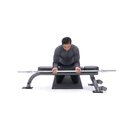

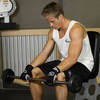

Conclusion
All good things must come to an end, as does this article. I hope you've enjoyed reading it, and by the time you finish this routine you should have packed a good amount of muscle on your arms.
Just remember: no matter what, always progress. Keep at it and you'll have to buy an entire new wardrobe in no time. Stay consistent, and have fun!
References
- Clarke MS., Feeback DL., Mechanical load induces sarcoplasmic wounding and FGF release in differentiated human skeletal muscle cultures. FASEB J. 10(4):502-509 1996

